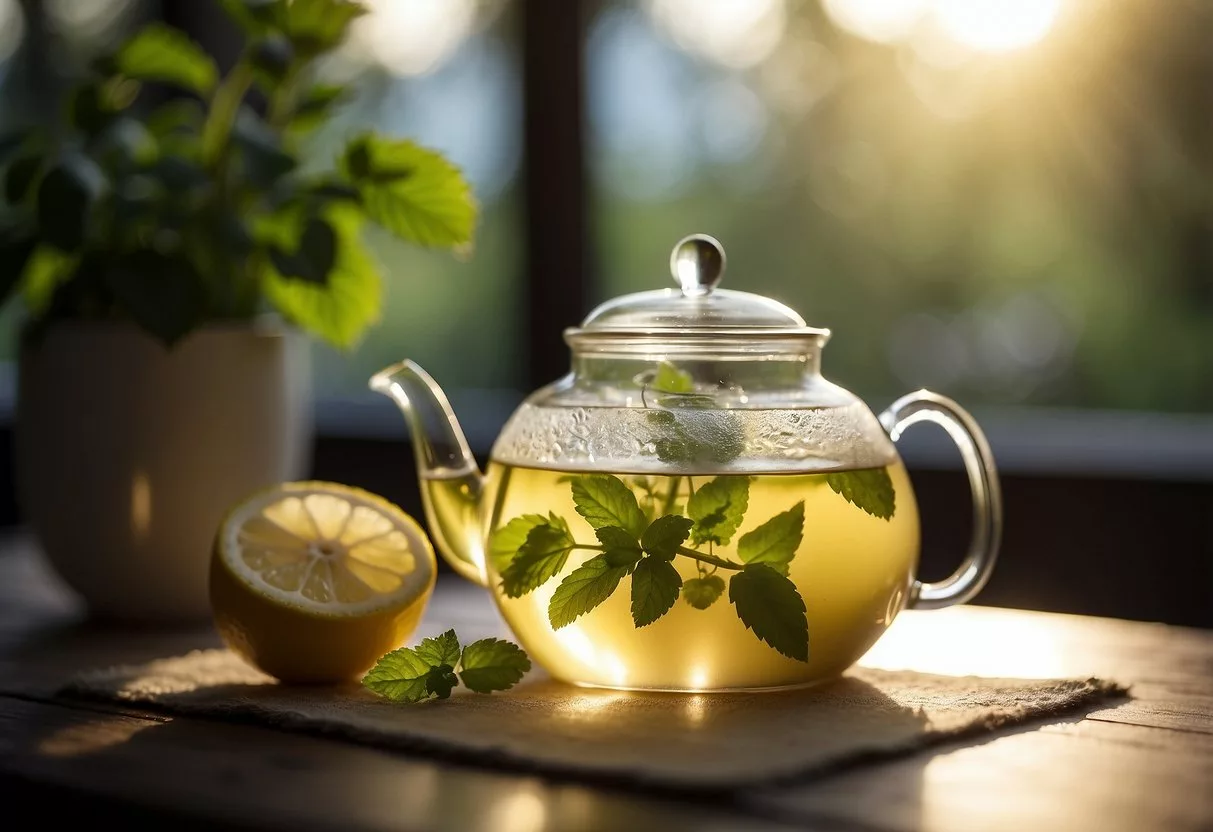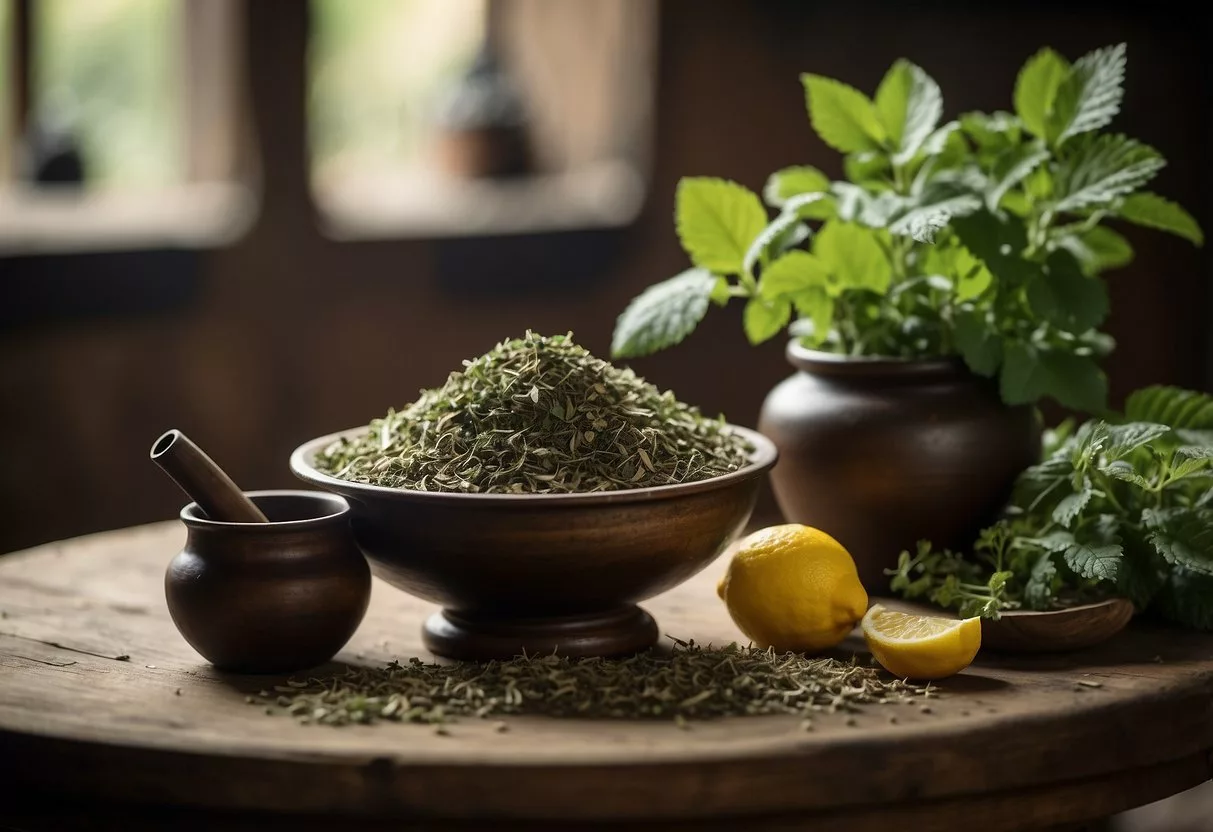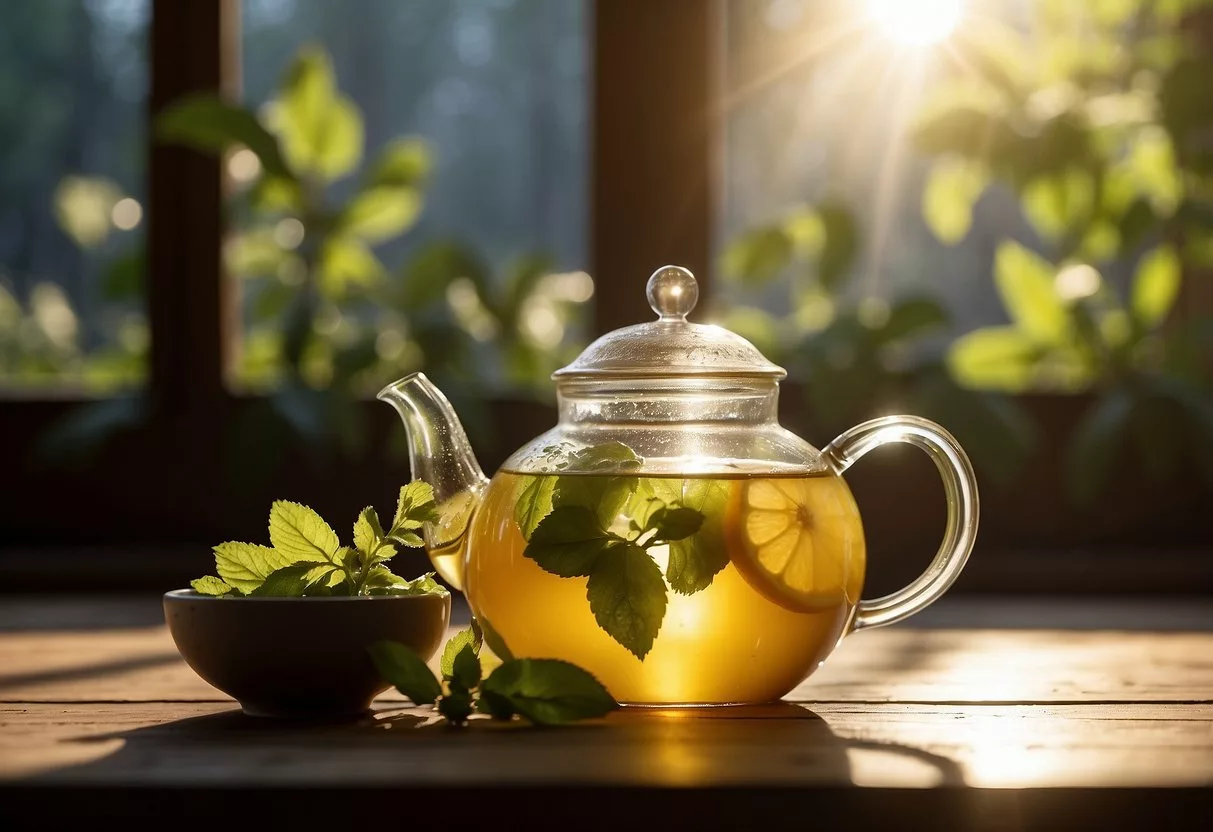Lemon balm tea, made from the leaves of the Melissa officinalis plant, is a popular herbal tea known for its calming properties. This soothing drink not only helps with anxiety and insomnia but also supports digestion and boosts the immune system. Whether you use fresh or dried leaves, lemon balm tea is a simple yet effective way to improve your well-being.

Preparing lemon balm tea is straightforward and can be done using various methods. Fresh or dried leaves are steeped in hot water for about 5-10 minutes, creating a fragrant, relaxing beverage. Some people enjoy adding honey or lemon to enhance its flavor and health benefits.
In addition to its therapeutic uses, lemon balm tea is also valued for its versatility in the kitchen. It’s often used as a garnish or an ingredient in various dishes, adding a subtle lemony taste. However, as with any herbal remedy, it’s important to be aware of potential side effects and consult with a healthcare provider if you have any concerns.
Key Takeaways
- Lemon balm tea helps with anxiety, insomnia, and digestion.
- Use fresh or dried leaves and steep for 5-10 minutes.
- Good for both drinking and culinary uses, but consult with a healthcare provider if needed.
Lemon Balm Tea Preparation

Making lemon balm tea is simple and can be done using a few basic ingredients and tools. You can brew it using fresh or dried leaves and customize it to suit your taste.
Ingredients and Tools
To make lemon balm tea, you need a few simple ingredients: fresh or dried lemon balm leaves, water, and optional sweeteners like honey. Using fresh leaves gives a more aromatic tea, while dried leaves are convenient for storage.
Tools required include:
- A teapot or mason jar
- A kettle for boiling water
- A mug for serving
- A spoon for measuring
If you want to get creative, you can also use tea bags or an infuser.
Step-by-Step Brewing
- Measure the Tea: Place 1 teaspoon of dried lemon balm or 2 tablespoons of fresh leaves in a teapot.
- Boil the Water: Bring water to a boil in a kettle. For 3 cups of tea, use 3 cups of water.
- Steep the Tea: Pour the boiling water over the leaves in the teapot. Cover and let it steep for 10-15 minutes. This ensures the flavors fully develop.
- Strain and Serve: Strain the tea into a mug or use an infuser to remove the leaves. Add honey or a slice of lemon if desired.
For a stronger tea, let the leaves steep longer. Refrigerate any leftover tea.
Variations and Serving Suggestions
Lemon balm tea is caffeine-free, making it perfect for any time of day. To make iced tea, let the tea cool and serve over ice.
You can also experiment with flavor by adding other herbs like mint or chamomile.
For a simple twist, add slices of fresh lemon or a sprinkle of ginger. Another option is to brew a large batch and store it in the refrigerator for a refreshing cold drink.
Keep experimenting to find your favorite way to enjoy lemon balm tea.
Therapeutic Benefits and Uses

Lemon balm tea offers various therapeutic benefits, particularly in promoting emotional well-being, aiding digestion, improving sleep, and possessing antioxidant and antiviral properties. The tea is also discussed for its potential benefits during pregnancy and for weight loss.
Emotional Well-being and Relaxation
Lemon balm tea is well-known for its calming effects. It helps reduce stress and anxiety, promoting a state of calm and relaxation. Studies suggest that lemon balm may help improve mood and mental clarity due to its mild sedative properties.
The soothing nature of this tea makes it useful for managing everyday stress. This can be beneficial for those experiencing heightened levels of anxiety or even mild depression.
Digestive Aid and Sleep Support
Lemon balm tea is often used to soothe digestive issues such as indigestion and bloating. Its antispasmodic properties help relax the digestive tract and can ease discomfort.
This herb is also beneficial in promoting better sleep. It helps those suffering from insomnia by calming the nervous system and reducing restlessness, aiding in a more restful night’s sleep.
Antioxidant and Antiviral Properties
Lemon balm is rich in antioxidants that help protect the body against oxidative stress. These antioxidants may support the immune system and reduce inflammation.
Its antiviral properties are particularly noteworthy. Lemon balm has been used to treat cold sores and herpes due to its effectiveness in inhibiting the virus’s activity. Regular consumption of lemon balm tea can thus aid in maintaining overall skin health.
Lemon Balm Tea Recipe for Weight Loss
Lemon balm tea can be included in a weight-loss regimen. It may help reduce stress-induced eating and improve overall well-being, making it easier to stick to a healthy diet.
To prepare, steep one teaspoon of dried lemon balm leaves in a cup of hot water for 10 minutes. For added benefits, combine it with green tea or a slice of lemon, which can boost metabolism and aid digestion.
Lemon Balm Tea for Pregnancy
During pregnancy, lemon balm tea can offer relief from common discomforts. Its calming effects can help manage pregnancy-related anxiety and stress.
It may also alleviate digestive issues like bloating and indigestion, which are common in pregnancy. However, it is advised to consult with a healthcare provider before adding any new herb or tea to the diet during pregnancy.
Culinary and Garnishing Tips

Lemon balm can add a touch of freshness and a mild lemon flavor to various dishes. It is versatile, suitable for both savory and sweet recipes, and offers visual appeal when used as a garnish.
Cooking with Lemon Balm
Lemon balm’s mild lemon flavor and herbaceous aroma make it an excellent addition to many dishes. Fresh lemon balm is preferred for its vibrant taste. Its leaves can be chopped and added to salads, soups, and fish dishes. It works well in marinades and can be used to flavor chicken or seafood.
Lemon balm can also be incorporated into dessert recipes. Try adding minced leaves to fruit salads, yogurt, or baked goods like muffins and cakes. It pairs especially well with lemon desserts, enhancing the citrus flavor without overpowering it. For a refreshing drink, infuse lemon balm in water or lemonade, giving a pleasant aroma and taste.
Decorative Uses in Cuisine
Lemon balm leaves are not just flavorful but also visually appealing. Whole or chopped leaves can serve as garnishes for various dishes and beverages. In savory dishes like grilled chicken or fish, placing a few fresh lemon balm leaves on top can make the dish more attractive.
In desserts, lemon balm can be used to decorate cakes, tarts, and pies. A sprinkle of finely sliced leaves can elevate the look and smell of the dessert. Beverages such as cocktails, iced teas, and lemonades benefit from a sprig of lemon balm, adding both flavor and a decorative touch. It also adds a nice aroma that complements the drink, making it more inviting to the senses.
Potential Side Effects and Precautions

Lemon balm tea is generally safe, but it can cause mild side effects and special populations like pregnant women and individuals with thyroid issues should take precautions.
Adverse Reactions and Allergies
Lemon balm tea can cause some mild side effects, including nausea, dizziness, and increased appetite. These are generally not severe but can be uncomfortable. Some people may also experience headaches after drinking the tea.
Allergic reactions are rare. Possible symptoms include skin rashes, itching, and swelling, especially for those sensitive to the mint family of plants.
It’s important to monitor how your body reacts. If any severe symptoms occur, stop consuming the tea and seek medical advice.
Considerations for Special Populations
Pregnancy and breastfeeding: Lemon balm tea is generally considered safe for short-term use, but its effects during pregnancy and breastfeeding are not well-studied. Therefore, it’s best for pregnant or breastfeeding women to consult a healthcare provider before drinking the tea.
Thyroid Hormones: Lemon balm can impact thyroid hormone levels. Individuals with thyroid disorders, such as hypothyroidism or hyperthyroidism, should use caution. The herb may interfere with thyroid medications.
Lastly, always consult a healthcare provider if you have any underlying health conditions or are taking other medications. They can provide personalized and safe recommendations.
Integrating Lemon Balm into Daily Life

Lemon balm can enhance well-being in various ways. It can be used in aromatherapy, as a topical application, or as a dietary supplement to improve mood and reduce stress.
Aromatherapy and Topical Applications
Lemon balm essential oil is popular in aromatherapy. It can calm the mind, reduce stress, and improve mood when diffused. Just add a few drops to a diffuser for a refreshing and calming atmosphere.
Topical applications, such as creams and ointments, often include lemon balm. Applying them to the skin can help with minor irritations or insect bites. Mixing lemon balm oil with a carrier oil like coconut oil makes it safe for direct skin application.
For a soothing bath, add a few drops of lemon balm oil to bathwater. This practice can help relax muscles and promote a sense of calmness.
Dietary Supplements and Concentrates
Lemon balm can be taken as a tincture, supplement, or extract. Supplements, available in capsules, provide a convenient way to ingest lemon balm. They are often used for stress relief and mood enhancement.
Lemon balm tinctures are liquid extracts that can be added to water or juice. A few drops can provide the benefits of the herb in a concentrated form, making it useful for those who require quick relief from anxiety.
Another form is lemon balm tea, which can be made by steeping dried or fresh leaves in hot water. It’s a simple way to integrate the herb into daily life to promote relaxation and stress relief.
Dietary concentrates can be mixed into smoothies or other drinks. These products are often potent, so follow dosage instructions carefully for safe and effective use.
The Historical Context of Lemon Balm

Lemon balm, or Melissa officinalis, has been used for many centuries both for its soothing properties and culinary uses. Historical texts and modern studies shed light on its multifaceted role throughout history.
Traditional Uses over the Centuries
Lemon balm has a rich history that traces back over 2,000 years to the Mediterranean region. In ancient Greece, it was considered a sacred herb in the Temple of Artemis. Beekeepers used it to attract bees, as it was believed to keep them well fed with nectar. The herb’s name, Melissa, means “bee” in Greek, reflecting this relationship.
During the Middle Ages, lemon balm was commonly used in European monasteries. It was incorporated into tonics to address various ailments. Medieval texts describe it as a remedy for stress and anxiety, highlighting its calming effects. As trade routes expanded, lemon balm spread to other parts of the world, including North America, where it continued to be valued for its versatility.
Modern Research and Findings
Contemporary studies have investigated the various benefits of lemon balm. Research suggests that it may help improve mood and cognitive function, aligning with traditional uses for stress relief. Lemon balm contains compounds like rosmarinic acid, which are believed to contribute to its calming effects.
Clinical trials have explored its potential to alleviate symptoms of conditions like anxiety and insomnia. Some studies have also examined its role in supporting cognitive health and memory. While more research is needed, initial findings are promising. Lemon balm is also noted for its antiviral and antioxidant properties, which may offer additional health benefits.
Modern herbalists continue to explore and validate these uses, solidifying lemon balm’s place in both traditional and contemporary medicine.
Growing and Maintaining Lemon Balm at Home

Lemon balm can be a delightful addition to your garden, providing a fresh source of leaves for tea. Easily grow this herb with the right planting, care, and harvesting techniques.
Planting and Care Tips
Start by selecting a sunny spot in your garden. Lemon balm thrives in well-drained soil and needs sunlight for most of the day.
Plant seeds about ¼ inch deep and keep the soil moist until they germinate. Once seedlings appear, thin them to 8 inches apart to give each plant enough room to grow. As plants mature, further thin them to 18 inches apart to ensure they don’t crowd each other.
They are hardy and can withstand temperatures as low as -20°F (-29°C). Regular watering is important but avoid waterlogging the soil to prevent root rot. To maintain plant quality, trim the tops regularly to encourage bushier growth.
Harvesting and Preserving
Harvest lemon balm leaves in the morning when their essential oils are most potent. Use sharp scissors to cut the leaves and avoid damaging the plant.
For the best flavor, collect leaves just before the plant starts to flower.
Dry the leaves by laying them on a screen in a well-ventilated area out of direct sunlight. Another method is to use an oven or a dehydrator set to low heat.
Once dried, store the leaves in an airtight container in a cool, dark place. Proper storage will preserve the flavor and aroma for a long time.
For optimal tea quality, use dried leaves within a year.
Pairing and Enhancing Flavors

Lemon balm tea pairs well with various herbs and teas that can enhance its natural lemony flavor. Creating unique blends and infusions allows for a more personalized tea experience.
Compatible Herbs and Teas
Lemon balm pairs beautifully with mint. Both belong to the same family and share a refreshing quality. Chamomile is another excellent pairing, providing a soothing effect that complements lemon balm’s calming properties.
Lavender adds a floral note, enhancing the overall flavor profile. Ginger can introduce a slight spice, making the tea more invigorating. For a more robust flavor, try combining lemon balm with green tea or black tea.
These combinations not only enhance flavor but also add various health benefits. For example, green tea adds antioxidants, while chamomile can further promote relaxation.
Creating Blends and Infusions
When creating your own blends, start with a base of dried lemon balm leaves. Add one teaspoon of dried lemon balm for each cup. Next, choose a secondary herb. For example, mix lemon balm with two teaspoons of dried mint for a refreshing tea.
To create a calming blend, combine lemon balm with one teaspoon of dried chamomile. Experiment by adding a small amount of fresh ginger to spice up the tea. For a floral touch, try half a teaspoon of dried lavender.
Infusing these ingredients together allows their flavors to meld. Always steep the tea for at least 10 minutes to ensure the flavors develop fully. Adjust the proportions to match your taste preferences.
For a cooler version, refrigerate the tea after straining and serve it iced. Enhance the flavor with a bit of honey or a slice of lemon if desired.
Frequently Asked Questions

Lemon balm tea offers several health benefits, including aiding digestion, reducing anxiety, and improving sleep. It is also worth noting how it can support weight loss and has potential benefits for the skin.
What are the health benefits associated with drinking lemon balm tea?
Lemon balm tea can help sooth digestive issues, improve sleep disorders, and reduce anxiety levels. It is also known to boost the immune system and help with cognitive function. Drinking this tea may also help alleviate menstrual symptoms and support overall wellness.
How can lemon balm tea contribute to weight loss efforts?
Lemon balm tea is low in calories and can be a good addition to a weight loss diet. The tea may help reduce stress and anxiety, which can reduce stress-related eating. Its calming effects might also improve sleep, which is important for weight management.
Are there any particular considerations for consuming lemon balm tea during pregnancy?
Pregnant women should consult with a healthcare provider before adding lemon balm tea to their diet. While lemon balm tea is natural, it is important to ensure it doesn’t interfere with pregnancy. Generally, herbal teas can have strong effects that might not be suitable during pregnancy.
Are there skin-related benefits to drinking lemon balm tea?
Drinking lemon balm tea can help improve skin health by reducing inflammation and combating acne. The antioxidants in lemon balm can also help protect the skin from damage caused by free radicals. Some people use lemon balm topically to soothe irritated skin.
What potential side effects should one be aware of when consuming lemon balm tea?
Potential side effects of drinking lemon balm tea include mild nausea, dizziness, and allergic reactions. It is generally safe for most people, but those on medication or with specific health conditions should consult with a healthcare provider. Overconsumption might lead to more noticeable side effects.
Is it more beneficial to consume lemon balm tea in the morning or before bed?
Lemon balm tea can be consumed both in the morning and before bed. In the morning, it can provide a calming start to the day. Before bed, it can help in relaxing and promoting a restful sleep. The best time might depend on personal preference and desired effects.